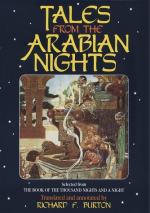feature, who play on sweet- toned instruments which
discourse heart-ravishing strains of melody;—meanwhile
the beauteous Peri Banu is seated on a throne adorned
with diamonds and rubies and emeralds, and pearls
and other gems, and by her side is the thrice-happy
Prince Ahmad, who feels himself amply indemnified
for the loss of his fair cousin Princess Nur-en-Nihar.
Auspicious was that day when he shot the arrow which
the enamoured Peri Banu caused to be wafted through
the air much farther than arm of flesh could ever
send the feathered messenger! And when the Prince
feels a natural longing to visit his father in the
land of mortals from time to time, behold the splendid
cavalcade issue from the portals of the fairy palace—the
gallant jinn-born cavaliers, mounted on superb steeds
with gorgeous housings, who accompany him to his father’s
capital. But alas! the brightest sky is sooner
or later overcast—human felicity is—etc.,
etc. The old king’s mind is poisoned
against his noble son by the whisperings of a malignant
and envious minister—a snake in the grass—a
fly in the ointment of Prince Ahmad’s beatitude!
And to think of the old witch gaining access to the
fairy palace— it was nothing less than
an atrocity! And the tasks which she induces the
king to set Prince Ahmad to perform—but
they are all accomplished for him by his fairy bride.
The only thing to regret—the fatal blemish
in the tale—is the slaughter of the old
king. Shabbar did right well to dash into the
smallest pieces the wicked vazir and the foul witch
and all who aided and abetted them, but “to
kill a king!” and a well-meaning if soft-headed
king, who was, like many better men, led astray by
evil counsellors!
Having thus blown off the steam—I mean
to say, having thus ventilated the enthusiasm engendered
by again reading the tale of Prince Ahmad and the Peri
Banu, I am now in a fitter frame of mind for the business
of examining some versions and variants of it, for
though the tale has not yet been found in Arabic,
it is known from the banks of Ganga to the snow-clad
hills and vales of Iceland—that strange
land whose heart is full of the fiercest fires.
This tale, like that of Zayn al-Asnam, comprises two
distinct stories, which have no necessary connection,
to wit, (1) the adventures of the Three Princes, each
in quest of the rarest treasure, wherewith to win the
beautiful Princess Nur-en-Nihar; and (2) the subsequent
history of the third Prince and the Peri Banu.
The oldest known form of the story concludes with the
recovery of the lady—not from death’s
door, but from a giant who had carried her off, and
the rival claims of the heroes to the hand of the
lady are left undecided: certainly a most unsatisfactory
ending, though it must be confessed the case was,
as the priest found that of Paddy and the stolen pullet,
somewhat “abstruse.” In the “Vetalapanchavinsati,”
or Twenty-five Tales of a Vampyre (concerning which
collection see Appendix to the preceding volumes, p.
230), the fifth recital is to this purpose:




